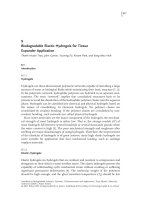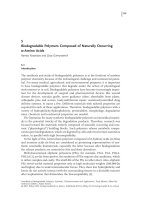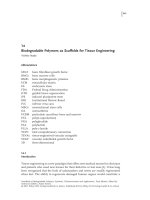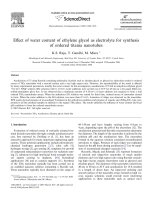Biodegradable Polymers as Scaffolds for Tissue Engineering
Bạn đang xem bản rút gọn của tài liệu. Xem và tải ngay bản đầy đủ của tài liệu tại đây (203.73 KB, 22 trang )
341
Biodegradable Polymers as Scaffolds for Tissue Engineering
Yoshito Ikada
Abbreviations
bFGF basic fi broblast growth factor
BMCs bone marrow cells
BMPs bone morphogenetic proteins
ECM extracellular matrix
ES embryonic stem
FDA Federal Drug Administration
GTR guided tissue regeneration
iPS induced pluripotent stem
IRB Institutional Review Board
IVC inferior vena cava
MSCs mesenchymal stem cells
OA osteoarthritis
PCBM particulate cancellous bone and marrow
PCL poly( ε - caprolactone)
PGA polyglycolide
PLA polylactide
PLLA poly - l - lactide
TCPC total cavopulmonary connection
TEVAs tissue - engineered vascular autografts
VEGF vascular endothelial growth factor
3D three - dimensional
14.1
Introduction
Tissue engineering is a new paradigm that offers new medical means for clinicians
and patients who need new tissues for their defective or lost ones [1] . It has long
been recognized that the limb of salamanders and newts are readily regenerated
when lost. The ability to regenerate damaged human organs would constitute a
Handbook of Biodegradable Polymers: Synthesis, Characterization and Applications, First Edition. Edited by
Andreas Lendlein, Adam Sisson.
© 2011 Wiley-VCH Verlag GmbH & Co. KGaA. Published 2011 by Wiley-VCH Verlag GmbH & Co. KGaA.
14
342
14 Biodegradable Polymers as Scaffolds for Tissue Engineering
medical revolution. However, the regeneration of human tissues is currently
almost impossible except for a few tissues including blood cells, epithelia, and
bones. The reason may be disclosed when the developmental biology will have
much more advanced in the near future.
Notwithstanding, it seems instructive for scientists and engineers of tissue
engineering to fi rst learn mechanisms of the natural development progress of
human embryo and adults, even if the biological environments for the embryonic
organogenesis are substantially different from those for the tissue regeneration in
adults.
14.2
Short Overview of Regenerative Biology
Throughout the history of experimental biology, certain organisms have repeatedly
attracted the attention of researchers. For instance, we cannot look at the phenom-
enon of limb regeneration in newts or starfi sh without wondering why we cannot
grow back our own arms and legs [2] . The reactivation of development in postem-
bryonic life to restore missing tissues has been a source of fascination to humans.
We are beginning to fi nd answers to the great problem of regeneration, so that
we might be able to alter the human body so as to permit our own limbs, nerves,
and organs to regenerate. This would mean that severed limbs could be restored,
that diseased organs could be removed and regrown, and that nerve cells altered
by age, disease, or trauma could once again function normally. To bring these
treatments to humanity, we fi rst have to understand how regeneration occurs in
those species that have this ability. Gilbert points out three major ways by which
regeneration can occur [2] . The fi rst mechanism involves the dedifferentiation of
adult structures to form an undifferentiated mass of cells that then become respec-
ifi ed. This type of regeneration is called epimorphosis, characteristic of regenerat-
ing limbs. The second mechanism is called morphallaxis. Here, regeneration
occurs through the repatterning of existing tissues with little new growth. Such
regeneration is seen in hydra. A third intermediate type of regeneration can be
thought of as compensatory regeneration. Here, the cells divide, but maintain their
differentiated functions. They produce cells similar to themselves and do not form
a mass of undifferentiated tissue.
14.2.1
Limb Regeneration of Urodeles
When an adult salamander limb is amputated, the remaining cells are able to
reconstruct a complete limb, with all its differentiated cells arranged in the proper
order. It is appropriate to begin with the example of the urodele amphibian limb,
simply because the adult urodele responds to amputation by regenerating a perfect
replica of the original limb.
14.2 Short Overview of Regenerative Biology
343
As a result of decades of research, we have considerable knowledge about the
cell - and tissue - level biology of limb regeneration [3] . Of particular signifi cance are
those fi ndings that indicate that once the regeneration cascade progresses to blast-
emal stages, the mechanisms controlling growth and pattern formation are the
same as those in developing limbs [4] . Thus, the challenge to understanding what
might be needed to induce regeneration in humans becomes focused on the
developmental signals controlling the transformation of the differentiated stump
into a blastema. In addition, a number of key requirements necessary for a suc-
cessful regeneration response have been disclosed. These include the formation
of a wound epidermis that creates a permissive environment necessary for a
regeneration response, the dedifferentiation of cells at the injury site, the require-
ment for adequate innervation, and the need to reinitiate patterning programs
involved in limb outgrowth. The absence of any one of these requirements will
result in regenerative failure. If we assume that the successful induction of limb
regeneration in higher vertebrates will proceed in a manner similar to urodeles,
then we can anticipate that all of these requirements must be satisfi ed at the
amputation site. These requirements for a regeneration response may be potential
barriers to regeneration in higher vertebrate limbs. Urodele limb regeneration is
characterized by the formation of a blastema composed of undifferentiated mes-
enchymal cells from which many of the different tissues of the regenerated limb
develop. Similarly, regeneration of developing tissues proceeds via a blastema - like
stage with the re - expression of developmentally relevant genes.
Despite the value of the urodele limb as a model for a regeneration, research
progress in recent years has been relatively slow due to diffi culties of bringing the
power of functional analysis to bear on urodeles. It seems likely that the critical
breakthroughs in regeneration research will come from the identifi cation of the
molecules that control the early events, preceding the convergence of the regenera-
tion and development pathways. Given techniques for effi cient high - throughput
screening and analysis of differentially expressed genes, combined with tech-
niques for identifying interacting molecules, urodeles will provide the opportunity
to identify all the candidate genes for the control of limb regeneration. With the
ability to test the function of these genes, it will be possible to identify the mole-
cules that regulate the key steps in the process, allowing for the realization of the
longed - for goal of human regeneration.
14.2.2
Wound Repair and Morphogenesis in the Embryo
Adult wound healing is notoriously imperfect and generally results in fi brosis and
scar contracture with poor reconstitution of epidermal and dermal structures at
the site of the healed wound, whereas embryonic wounds heal extremely well,
rapidly, effi ciently, and perfectly.
Adult wound closure involves active movements of both connective tissue and
epidermis. The exposed connective tissue of the wound – the granulation
344
14 Biodegradable Polymers as Scaffolds for Tissue Engineering
tissue – contracts to tug the wound edges together and, as this is happening, the
epidermis migrates to cover over the exposed connective tissue. The embryo also
utilizes a combination of connective tissue contraction and re - epithelialization
movements to close a wound, but the cellular mechanisms for both movements
are quite different in embryo and adult. Another major difference between adult
and embryonic tissue repair concerns the extent of infl ammation during healing – at
adult wound sites, there is always an extensive infl ammatory response, but in the
embryo, infl ammation is minimal, if not nonexistent. Wound healing is an initial
and critical event in any regeneration response. If wound healing occurs perfectly,
that is, without scarring, then the skin (epidermal and dermal tissues) can be
considered to have regenerated. Indeed, embryonic and fetal wounds heal rapidly
without scarring, just as embryonic limb buds and fetal digits are able to respond
to amputation by mounting a regenerative response. During a limb regenerative
response, wound closure results in the formation of a specialized structure, the
wound epidermis, which creates a subepidermal environment essential for regen-
eration. It seems likely that a similar type of subepidermal environment will be
necessary for a regeneration response during healing of the skin. It seems unlikely
that successful limb regeneration can occur under healing conditions that results
in the deposition of scar tissue. Thus, scar - free wound healing is likely to be a
necessary precondition for a successful regeneration response.
14.2.3
Regeneration in Human Fingertips
The transition from urodele limb studies to experimental attempts to induce a
regenerative response in higher vertebrates has met with few successes, none
resulting in a normal limb. This has led to the general conclusion that a “ magic
bullet ” for regeneration is unlikely, but that the induction of a regeneration
response will involve a coordinated effort to overcome multiple barriers to regen-
eration. While the regenerating urodele limb is the system of choice, alternative
approaches are to study the limited regenerative responses that are known to occur
in the limbs of higher vertebrates: digit tip regeneration in adult mammals. In
fact, human digit tips can regenerate. Digit tip regeneration in adult primates
(including humans) and rodents occurs without the formation of a blastema;
instead, fi broblastic cells appear to be involved in the regeneration response. Fin-
gertip amputations are among the most common traumas seen in hospital emer-
gency rooms [5] . There are numerous reports that a conservative treatment
consisting simply of covering the amputation wound with sterile dressings and
allowing it to heal by secondary intention (i.e., without assisted wound closure)
will result in the regeneration of the missing distal portion of the fi nger [6] . The
phenomenon of fi ngertip regeneration in humans was initially described for chil-
dren, but later shown to extend to adults. For both children and adults, regenera-
tion of the fi ngertip involves the integrated regeneration of many tissues including
nail matrix, nail bed, fi nger pulp, sensory organs, dermis, and epidermis, all of
which reform to a normal or nearnormal cosmetic and physiological state through
14.2 Short Overview of Regenerative Biology
345
healing by secondary intention. Elongation of the distal phalangeal bone during
regeneration has only been documented for children [7] , but most studies lack
radiographic data that allow for the assessment of bone regrowth. Animal models
for digit tip regeneration in adults demonstrate distal bone growth associated with
a regeneration response. There are several documented instances of regeneration
of the distal phalangeal element of the toe following traumatic injury or voluntary
resection to relieve hummer toe [8] . Thus, it would appear that the regenerative
capabilities in human limbs include the tips of both fi ngers and toes.
14.2.4
The Development of Bones: Osteogenesis
The skeleton is generated through three lineages: the somites generate the axial
skeleton, the lateral plate mesoderm generates the limb skeleton, and the cranial
neural crest gives rise to the branchial arch and craniofacial bones and cartilage.
There are two major modes of bone formation or osteogenesis, and both involve
the transformation of a preexisting mesenchymal tissue into bone tissue. The
direct conversion of mesenchymal tissue into bone is called intramembranous
ossifi cation. In other cases, the mesenchymal cells differentiate into cartilage, and
this cartilage is later replaced by bone. The process by which a cartilage intermedi-
ate is formed and replaced by bone cells is called endochondral ossifi cation. The
cranial neural crest cells form bones through intramembranous ossifi cation. In
the skull, neural crest - derived mesenchymal cells proliferate and condense into
compact nodules. As shown in Figure 14.1 , some of these cells develop into capil-
laries; others change their shape to become osteoblasts, committed bone precursor
cells. The osteoblasts secrete a collagen – proteoglycan osteoid matrix that is able
to bind calcium. Upon embedding in the calcifi ed matrix, osteoblasts become
osteocytes. As calcifi cation proceeds, bony spicules radiate out from the region
Figure 14.1
Schematic diagram of intramembranous ossifi cation.
Osteoid
matrix
Osteblasts
Loose mesenchyme Blood vessel Osteoblasts
Calcified
bone
Bone cell
(osteocyte)
346
14 Biodegradable Polymers as Scaffolds for Tissue Engineering
where ossifi cation began. Furthermore, the entire region of calcifi ed spicules
becomes surrounded by compact mesenchymal cells that form the periosteum.
The cells on the inner surface of the periosteum also become osteoblasts and
deposit matrix parallel to the existing spicules. The mechanism of intramembra-
nous ossifi cation involves bone morphogenetic protein s ( BMP s) and the activation
of a transcription factor called Runx2.
Endochondral ossifi cation involves the formation of cartilage tissue from aggre-
gated mesenchymal cells and the subsequent replacement of cartilage tissue by
bone [9] . This is the type of bone formation characteristic of the vertebrae, ribs,
and limbs. The process of endochondral ossifi cation can be divided into fi ve stages,
as shown in Figure 14.2 . First, the mesenchymal cells commit to becoming carti-
lage cells. This commitment is caused by paracrine factors that induce the nearby
mesodermal cells to express two transcription factors, which will then activate
Figure 14.2
Schematic diagram of endochondral ossifi cation.
Proliferating
chondrocytes
a) b) c) d)
e) f) g) h)
Epiphyseal
cartilage
Growth plate
Bone marrow
Bone
Growth plate
}
}
}
Secondary ossification center
Mesenchyme
Cartilage
Hypertrophi
chondrocyte
Blood
vessel
Osteoblasts
(bone)
14.2 Short Overview of Regenerative Biology
347
cartilage - specifi c genes. During the second phase of endochondral ossifi cation, the
committed mesenchymal cells condense into compact nodules and differentiate
into chondrocytes.
During the third phase of endochondral ossifi cation, the chondrocytes prolifer-
ate rapidly to form the cartilage model for the bone. As they divide, the chondro-
cytes secrete a cartilage - specifi c extracellular matrix ( ECM ). In the fourth phase,
the chondrocytes stop dividing and increase their volume dramatically, becoming
hypertrophic chondrocytes. These large chondrocytes alter the matrix they produce
(by adding collagen X and more fi bronectin) to enable it to become mineralized
by calcium carbonate. They also secrete the angiogenesis factor, vascular endothe-
lial growth factor ( VEGF ), which can transform mesodermal mesenchymal cells
into blood vessels. A number of events lead to the hypertrophy and mineralization
of the chondrocytes, including an initial switch from aerobic to anaerobic respira-
tion, which alters their cell metabolism and mitochondrial energy potential.
Hypertrophic chondrocytes secrete numerous small membrane - bound vesicles
into the ECM. These vesicles contain enzymes that are active in the generation of
calcium and phosphate ions and initiate the mineralization process within the
cartilaginous matrix. The hypertrophic chondrocytes, their metabolism and mito-
chondrial membranes altered, then die by apoptosis.
In the fi fth phase, the blood vessels induced by VEGF invade the cartilage model.
As the hypertrophic chondrocytes die, the cells that surround the cartilage model
differentiate into osteoblasts. These cells express the Runx2 transcription factor,
which is necessary for the development of both intramembranous and endochon-
dral bone. The replacement of chondrocytes by bone cells is dependent on the
mineralization of the ECM. This remodeling releases VEGF, and more blood
vessels are made around the dying cartilage. These blood vessels bring in both
osteoblasts and chondroclasts (which eat the debris of the apoptotic chondrocytes).
Eventually, all the cartilage is replaced by bone. Thus, the cartilage tissue serves
as a model for the bone that follows.
14.2.5
Regeneration in Liver: Compensatory Regeneration
Today, the standard assay for liver regeneration is to remove specifi c lobes of the
liver (i.e., a partial hepatectomy), leaving the others intact. The removed lobe does
not grow back, but the remaining lobes enlarge to compensate for the loss of the
missing liver tissue. The amount of liver regenerated is equivalent to the amount
of liver removed. The liver regenerates by the proliferation of the existing tissues.
The regenerating liver cells do not fully dedifferentiate when they reenter the cell
cycle. No regeneration blastema is formed. Rather, the fi ve types of liver cells – hepa-
tocytes, duct cells, fat - storing (Ito) cells, endothelial cells, and Kupffer macro-
phages – each begin dividing to produce more of themselves. Each type of cell
retains its cellular identity, and the liver retains its ability to synthesize the liver -
specifi c enzymes necessary for glucose regulation, toxin degradation, bile synthe-
sis, albumin production, and other hepatic functions. As in the regenerating
348
14 Biodegradable Polymers as Scaffolds for Tissue Engineering
salamander limb, there is a return to some embryonic conditions in the regenerat-
ing liver. Fetal transcription factors and products are made, as are the cyclins that
control cell division. But the return to the embryonic state is not as complete as
in the amphibian limb.
14.3
Minimum Requirements for Tissue Engineering
14.3.1
Cells and Growth Factors
The leading player in tissue engineering is cells because it is only this living
microsystem that is able to regenerate living tissues. This is different from the
conventional artifi cial organs and tissues, where biomaterials play a pivotal role.
Very recently, pluripotent stem cells such as embryonic stem ( ES ) and induced
pluripotent stem (iPS) cells have attracted extraordinarily much attention, but
these cells cannot be applied directly to tissue engineering. The cells applicable to
tissue engineering should be differentiated to regenerate target tissues or will be
readily differentiated depending on the environment surrounding the prediffer-
entiated cells. The cells closely associated with tissue engineering include fi brob-
last, osteoblast, chondrocyte, epithelial cell, and smooth muscle cell. In addition,
it should be mentioned that numerous organs contain multipotent stem cells, even
in the adult. Multipotent stem cells can give rise to a limited set of adult tissue
types. However, they are not as easy to use as pluripotent ES cells. First, they
appear to have a relatively low rate of cell division and do not proliferate readily.
Second, they are diffi cult to isolate, and are often fewer than one of every thousand
cells in an organ. The mesenchymal stem cell s ( MSC s) from the bone marrow are
still relatively undifferentiated, but commited to a certain lineage, and have the
capability to readily differentiate based on the circumstance.
To produce a clinically applicable size of tissues by tissue engineering, we need
a large number of cells, but the amount of cells that can be harvested from patients
is limited. Therefore, attempts have been made to multiply the harvested cells
retaining the ability to generate tissues. One of the unsolved problems in tissue
engineering is to multiply the MSC keeping the undifferentiated state. If this is
achieved in culture, the benefi t is potentially enormous. An addition of high con-
centrations of basic fi broblast growth factor ( bFGF ) in culture has been claimed
to facilitate the MSC multiplication [10] , but the positive effect has not always been
reported.
Cytokines greatly affect tissue engineering in terms of cell multiplication, cell
differentiation, and neovascularization. A well - known example is BMPs that are
able to induce ectopic bone formation without any cell addition. Similarly, bFGF
encourages capillary formation without exogenous cell addition. Such vasculariza-
tion is critical for nutrient supply to cells in the regeneration site. An important









